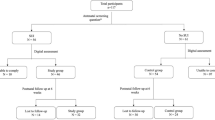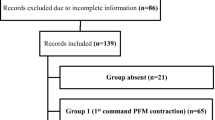Abstract
The aims of the study were: (1) to assess women performing voluntary pelvic floor muscle (PFM) contractions, on initial instruction without biofeedback teaching, using transperineal ultrasound, manual muscle testing, and perineometry and (2) to assess for associations between the different measurements of PFM function. Sixty continent (30 nulliparous and 30 parous) and 60 incontinent (30 stress urinary incontinence (SUI) and 30 urge urinary incontinence (UUI)) women were assessed. Bladder neck depression during attempts to perform an elevating pelvic floor muscle (PFM) contraction occurred in 17% of continent and 30% of incontinent women. The UUI group had the highest proportion of women who depressed the bladder neck (40%), although this was not statistically significant (p=0.060). The continent women were stronger on manual muscle testing (p=0.001) and perineometry (p=0.019) and had greater PFM endurance (p<0.001) than the incontinent women. There was a strong tendency for the continent women to have a greater degree of bladder neck elevation than the incontinent women (p=0.051). There was a moderate correlation between bladder neck movement during PFM contraction measured by ultrasound and PFM strength assessed by manual muscle testing (r=0.58, p=0.01) and perineometry (r=0.43, p=0.01). The observation that many women were performing PFM exercises incorrectly reinforces the need for individual PFM assessment with a skilled practitioner. The significant correlation between the measurements of bladder neck elevation during PFM contraction and PFM strength measured using MMT and perineometry supports the use of ultrasound in the assessment of PFM function; however, the correlation was only moderate and, therefore, indicates that the different measurement tools assess different aspects of PFM function. It is recommended that physiotherapists use a combination of assessment tools to evaluate the different aspects of PFM function that are important for continence. Ultrasound is useful to determine the direction of pelvic floor movement in the clinical assessment of pelvic floor muscle function in a mixed subject population.


Similar content being viewed by others
References
Bo K, Sherburn M (2005) Evaluation of female pelvic-floor muscle function and strength. Phys Ther 85(3):269–282
Bo K, Sherburn M, Allen T (2003) Transabdominal ultrasound measurement of pelvic floor muscle activity when activated directly or via a transversus abdominis muscle contraction. Neurourol Urodyn 22(6):582–588
Dietz HP, Wilson PD, Clarke B (2001) The use of perineal ultrasound to quantify levator activity and teach pelvic floor muscle exercises. Int Urogynecol J Pelvic Floor Dysfunct 12(3):166–169
Bo K et al (1990) Pelvic floor muscle exercises for the treatment of female stress urinary incontinence:11. Validity of vaginal pressure measurements of pelvic floor muscle strength and the necessity of supplementary methods for control of correct contraction. Neurourol and Urodyn 9:479–487
Dietz HP, Jarvis SK, Vancaillie TG (2002) The assessment of levator muscle strength: a validation of three ultrasound techniques. Int Urogynecol J Pelvic Floor Dysfunct 13(3):156–159; Discussion 159
Thompson J, O’Sullivan P (2003) Levator plate movement during voluntary pelvic floor muscle contraction in subjects with incontinence and prolapse: a cross sectional study and review. Int Urogynecol J Pelvic Floor Dysfunct 12(4):84–88
Dietz HP, Steensma AB, Vancaillie TG (2003) Levator function in nulliparous women. Int Urogynecol J Pelvic Floor Dysfunct 14(1):24–26
Wijma J, Tinga D, Visser H (1991) Perineal ultrasound in women with stress incontinence and controls: the role of the pelvic floor muscles. Gynecol Obstet Investig (32):176–179
Peschers UM et al (1997) Levator ani function before and after childbirth. Br J Obstet Gynaecol 104(9):1004–1008
Dietz HP (2004) Levator function before and after childbirth. Aust N Z J Obstet Gynaecol 44(1):19–23
Ishiko O et al (2000) The urinary incontinence score in the diagnosis of female urinary incontinence. Int Jnl Gynaecol Obstet 68:131–137
Sandvik H et al (1993) Validation of a severity index in female urinary incontinence and its implementation in an epidemiological survey. J Epidemiol Community Health 47(6):497–499
Thompson J et al (2005) Assessment of pelvic floor movement using transabdominal and transperineal ultrasound. Int Urogynecol J Pelvic Floor Dysfunct 16(4):285–292
Sapsford R, Bullock-Saxton J, Markwell S (1998) Women’s Health. A Textbook for Physiotherapists. WB Saunders Company, London
Bump RC et al (1991) Assessment of Kegel pelvic muscle exercise performance after brief verbal instruction. Am J Obstet Gynecol 165(2):322–329
Theofrastous JP et al (1997) Relationship between urethral and vaginal pressures during pelvic muscle contraction. The Continence Program for Women Research Group. Neurourol Urodyn 16(6):553–558
Thompson J et al (2005) Altered muscle activation patterns in symptomatic women during pelvic floor muscle contraction and valsalva manouevre. Neurourol Urodyn 24(5/6):517
Bo K (2003) Pelvic floor muscle strength and response to pelvic floor muscle training for stress urinary incontinence. Neurourol Urodyn 22(7):654–658
Deindl F et al (1994) Pelvic floor activity patterns: comparison of nulliparous continent and parous urinary stress incontinent women. A kinesiological EMG study. Br J Urol 73:413–417
Morin M et al (2004) Pelvic floor muscle function in continent and stress urinary incontinent women using dynamometric measurements. Neurourol Urodyn 23(7):668–674
Laycock J, Jerwood D (2001) Pelvic floor muscle assessment: the PERFECT scheme. Physiotherapy 87(12):631–642
Acknowledgements
The following are acknowledged: Curtin University Postgraduate Scholarship Awards and the Physiotherapy Research Foundation of Australia for financial assistance; Dr Anthony Murphy for use of ultrasound equipment; Sarah Court for research assistance; and Dr Ritu Gupta for statistical advice.
Author information
Authors and Affiliations
Corresponding author
Rights and permissions
About this article
Cite this article
Thompson, J.A., O’Sullivan, P.B., Briffa, N.K. et al. Assessment of voluntary pelvic floor muscle contraction in continent and incontinent women using transperineal ultrasound, manual muscle testing and vaginal squeeze pressure measurements. Int Urogynecol J 17, 624–630 (2006). https://doi.org/10.1007/s00192-006-0081-2
Received:
Accepted:
Published:
Issue Date:
DOI: https://doi.org/10.1007/s00192-006-0081-2




